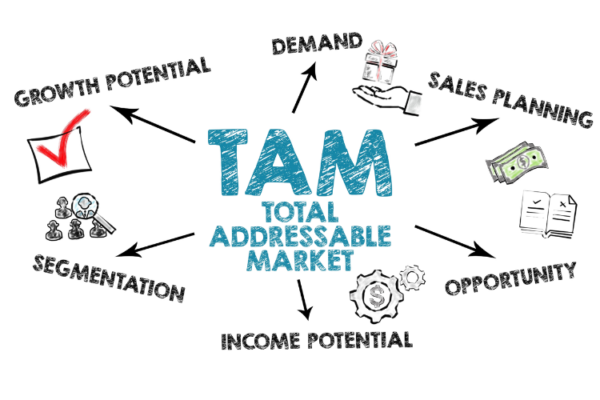Total Addressable Market (TAM) is an essential metric used by investors, marketers, and strategic business leaders to assess the size and potential growth of a market. It is a critical first step in a series of measurements that give businesses leaders a better understanding of market opportunity.
Total Addressable Market (TAM), along with Serviceable Addressable Market (SAM) and Serviceable Obtainable Market (SOM), give organisations a better understanding of their in-market potential and guide product and business strategy decisions.
In this blog post, we will focus on how to assess market size and potential growth, through TAM and how to use this calculation as a first step to inform your investment or go-to-market strategy.
What is Total Addressable Market (TAM)?
Total Addressable Market, also referred to as total available market, is the estimated size of the market for a product or service. It is calculated by taking the number of potential customers in a market and multiplying it by the average revenue per customer. The result is an estimate of the total revenue opportunity for a company in each market.
Potential customer in market X average revenue per customer = total revenue opportunity
Why is TAM important?
This information is critical for informed decision-making and helps to determine the feasibility of a product or service. TAM also helps to identify potential markets, prioritise resources, and allocate investments effectively.
How to calculate TAM?
There are two primary approaches to calculate TAM: top-down and bottom-up. Let’s delve into each method.
Top-down Approach:
- Define the market: Start by identifying the broader market your product or service caters to determine the industry or sector your business operates within.
- Gather industry data: Research industry reports, market studies, database platforms and authoritative sources for relevant data. Look for statistics on overall market size, growth rates, and key trends.
- Calculate TAM: Multiply the total number of potential customers in the market by the average revenue per customer.
Example: If there are 10 million potential customers in the market, and the average revenue per customer is $50, your TAM would be $500 million.
Why use the top-down approach?
A simpler calculation and can be used for basic business modelling for those companies with limited internal and customer data.
It gives a high-level overview: This is useful for strategic planning, especially at the corporate level.
It allows for comparative analysis: Top-down analysis allows for industry benchmarking by considering overall market trends, growth rates, and potential. It is valuable for assessing how a business fits into the broader market landscape.
Helps make macro-level decision making: Business marketers, especially in larger organisations, often need to make high-level, macro decisions. The top-down approach facilitates these decisions by providing a holistic view of the market.
Allows for resource planning: For businesses with a broad product or service portfolio, the top-down approach helps in allocating resources across different business units or product lines based on the overall market size and potential.
Bottom-up approach
- Identify customer segments: Break down the market into specific customer segments or niches. Define your target audience and understand their characteristics.
- Calculate TAM: Determine the Average Revenue Per User (ARPU) or customer within each segment. Multiply the ARPU by the estimated number of potential customers in each segment.Sum up the segment values to get the overall TAM.
Example: If your product targets three segments, for example enterprise, mid-market, and small market, you might calculate your TAM for each segment as $30 million (Enterprise), $40 million (Mid-size), and $20 million (Small), with the total TAM at $90 million.
Why use the bottom-up approach?
Investors and entrepreneurs prefer this approach due to the following detail:
Focus on specifics: Provides more detailed and granular understanding of the market. Breaking down the market into segments allows for a more accurate assessment of potential revenue streams.
Operational insight: Entrepreneurs need a clear understanding of their business operations and how they can penetrate different customer segments. Bottom-up analysis enables them to plan and allocate resources based on specific customer needs.
Risk mitigation: Investors, particularly those in early-stage start-ups, prefer bottom-up analysis as it helps mitigate market risk. By focusing on specific customer segments and validating demand, they can make more informed investment decisions.
Adaptability: Entrepreneurs can adjust their strategies based on the dynamics of each customer segment, responding quickly to changing market conditions.
Validation through traction: Entrepreneurs often use the bottom-up approach to validate their assumptions through early product launches or pilot programs, gaining real-world traction before scaling.
Both approaches involve multiplying the number of potential customers by the average revenue per customer, but the top-down approach starts with an overall market size, while the bottom-up approach breaks it down into specific customer segments for a more detailed analysis. The choice depends on the specific goals, context, and stage of the business.
Using TAM to inform your strategy
Once you have calculated TAM, it can be used to inform your investment or go-to-market strategy in several ways:
Identifying potential market: Using our TAM, we can identify potential segments or opportunities for our product and service. If our we use our bottom-up segments we can see that mid-size organisations have a higher potential market than the other segments and a prioritisation of focus and allocate investment should be focused on this segment.
Prioritising resources: TAM helps to prioritise resources by determining the feasibility of a product or service and the potential for market share growth. If our priority is in the mid-market segment, then we would need to look at resourcing across this segment. Sales team with mid-market experience or connections and go-to market plans with focus on Ideal Customer Profile (ICP) of this segment.
Allocating investments: TAM also helps to allocate investments by providing an estimate of the total revenue opportunity for a company. This investment could be in product development to specifically capture demand from the mid-market segment.
How to find the size of your market?
The first step in calculating Total Addressable Market (TAM) is to determine the size of the market. This involves identifying the target customer segments and the number of potential customers in each segment. There are several resources and methods you can use to build out this number:
1. Data analysis: Data analysis is a process of analysing data to identify patterns, trends, and relationships. In the context of TAM calculation, data analysis can be used to determine the size of the market by analysing demographic data, sales data, and other relevant data sources.
2. Market research: Market research is a process that involves gathering information about a target market. This can be done through surveys, focus groups, and firsthand interviews. To complement this research, reports, and data from industry analyst firms such as IBISWorld and Gartner, as well as government websites, will provide valuable information about the market’s size, customer behaviour, and the needs and wants of target customers.
3. Market surveys: Market surveys are a method of gathering information about a target market by asking questions to a sample of potential customers. Surveys can be conducted in-person, by phone, or online, and they can provide valuable information about the size of the market, customer behaviour, and the needs and wants of target customers.
Tools and technology
here are several tools and technologies that can assist in determining the size of a market, including:
- Database platforms: Using tools like the Firmable B2B database, you can quickly find how many businesses match your target market criteria and then use this tool to gain further demographic data on location, revenue, employee size to name a few.
- Customer Relationship Management (CRM) software: CRM software can be used to store and analyse customer data, including demographic information, purchasing behaviour, and other relevant information.
- Market intelligence softwareMarket intelligence software is designed to provide data and insights about target markets, including market size, growth, and competition.
Conclusion
By incorporating your TAM metrics, businesses can now enhance their understanding of market opportunities, allocate resources effectively, and make informed decisions that propel growth. Sign up for a 14-day free trial of Firmable and get started on your TAM today!
Don’t miss our follow up blog in this series, where we will look at “Understanding your Serviceable Addressable Market (SAM), and why it is important”. Sign up to our blog alerts, to not miss out.




